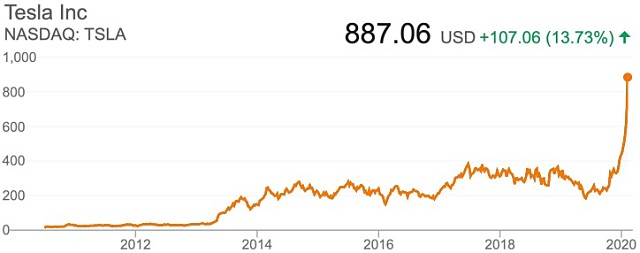What’s behind Tesla’s share price surge in 2020?

Tesla’s share price has risen over 160% since the beginning of the year.
Renowned globally for its chief executive officer Elon Musk and the company’s electric vehicles and energy storage solutions, Tesla (NASDQ: TSLA) has come under the global spotlight further in recent weeks due to its rocketing share price.
On the 2 December, Tesla’s shares were trading at US$334.87 each on the Nasdaq, but since then the company’s share price has rocketed 165% to close Tuesday this week at US$887.06 after reaching an intraday high of US$968.99 a few hours before market close.

Although the company’s share price has been on the rise since December, the upward momentum rapidly picked up pace at the start of this month.
The company ended a positive January at US$650.57 and had gained almost US$130 per share by Monday 3 February when it closed at US$780.
By end of trade Tuesday, Tesla had added another US$100 to its share price – and pushed its market cap out to US$160 billion.
The recent surge has propelled the electric vehicle developer above traditional car manufacturers including Fiat Chrysler, Ford and General Motors, which have current market caps between US$26-50 billion.
Speculators have been bandying about various triggers for the February share price surge with most believing it is a combination of factors including an encouraging December 2019 quarter performance, followed by analysts becoming more bullish on the stock and lifting their forecasts.
Unlucky short sellers have also been blamed.
Tesla’s performance in 2019
At the end of January, Tesla revealed 2019 had been a “turning point” for the company, driven by strong organic demand for its Model 3 electric vehicle and “persistent cost control”.
Underpinning the strong 2019 was record vehicle deliveries of 112,094 and storage deployment in the December quarter.
Although 2019 full year profits were flat, Tesla did meet its 2019 guidance for vehicle sales – delivering 367,500 for the year.
Total revenue for the December period was US$7.38 billion to generate a gross profit of US$1.39 billion – up 17% on the previous September quarter, although down 4% on the corresponding 2018 period.

Tesla sold a record 300,885 Model 3 electric vehicles in 2019.
Tesla finished the quarter by adding US$930 million to its cash and cash equivalents – boosting its balance to US$6.3 billion.
Underpinning this cash boost was $1 billion in free cash flow for the period.
In its 2020 outlook, Tesla expects vehicle deliveries to exceed 500,000, due to higher production of Model 3 in Shanghai and Model Y in Fremont.
The company also anticipates strong growth in its solar and storage deployments, with these business segments anticipated to expand 50% this year.
Tesla is also predicting positive quarterly free cash flow and net income as the year advances.
Bullish analyst commentary
Since Tesla’s positive December quarter results, analysts have revised their outlook for the stock.
Citing the positive results and outlook for his decision, Argus analyst William Selesky lifted his 12-month outlook for Tesla’s shares from US$556 to US$808.
Another analyst exceptionally bullish on Tesla’s outlook is ARK Invest, which predicts the company’s shares will reach US$7,000 by 2024.
The analyst bases this on an assumption electric vehicle costs will decline, while demand will accelerate.
ARK also noted that Mr Musk’s self-driving robotaxi business could be a key driver of this increase.
Using combined data of six other analysts recommending Tesla in the last three months, the forecast average price target is US$496.15, with a high case estimate of US$808 and a low case scenario of US$44.52.
Short sellers fuel the fire
In addition to bullish analysts and positive results, many speculators have blamed short sellers for the share price surge.
For those unfamiliar with short selling, the term refers to where experienced traders borrow shares from a broker or dealer with the strategy of making a profit on the shares before returning them to the lender.
Short sellers do this by promptly selling the shares to buyers willing to pay the market price.
The experienced trader is now “short” of its shares because it has sold shares it does not own.
To make a profit, the trader is betting the stock price will fall. If that happens, the trader will scoop the stock back up at a lower price and then issue it back to the lender.
In Tesla’s case, it is estimated a fifth of the company’s shares traded on market are sold short, with traders anticipating the stock will drop.
However, as Tesla’s shares keep rocketing, short sellers are forced to repurchase their stock back at even higher prices – losing profits and driving the share price even further.
